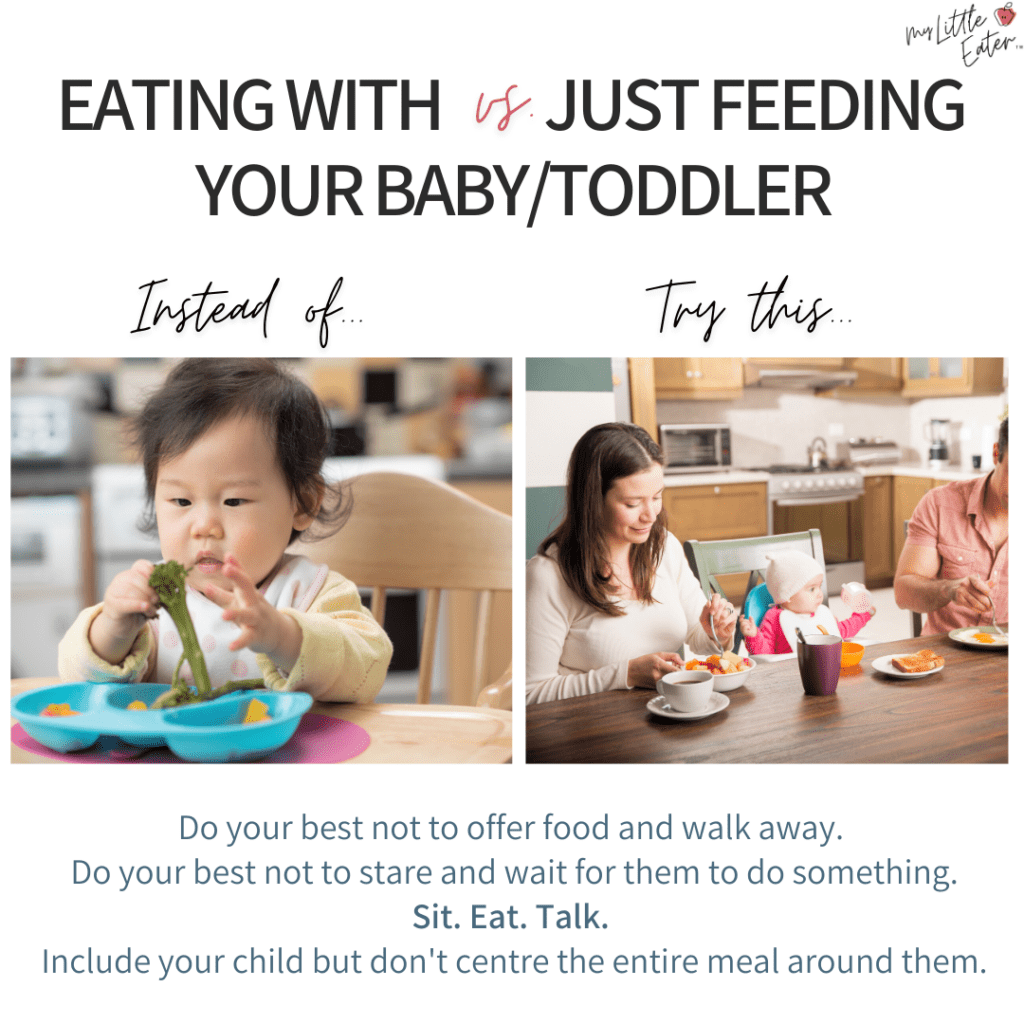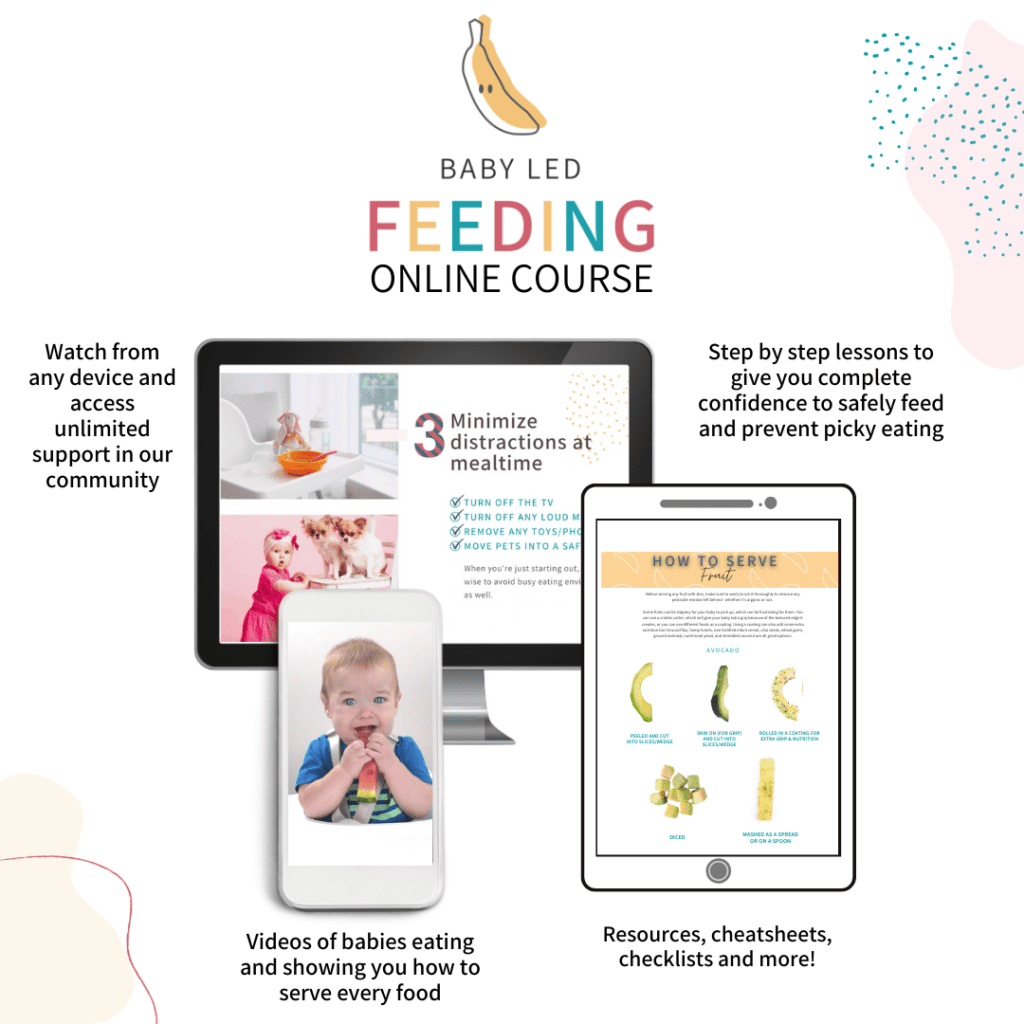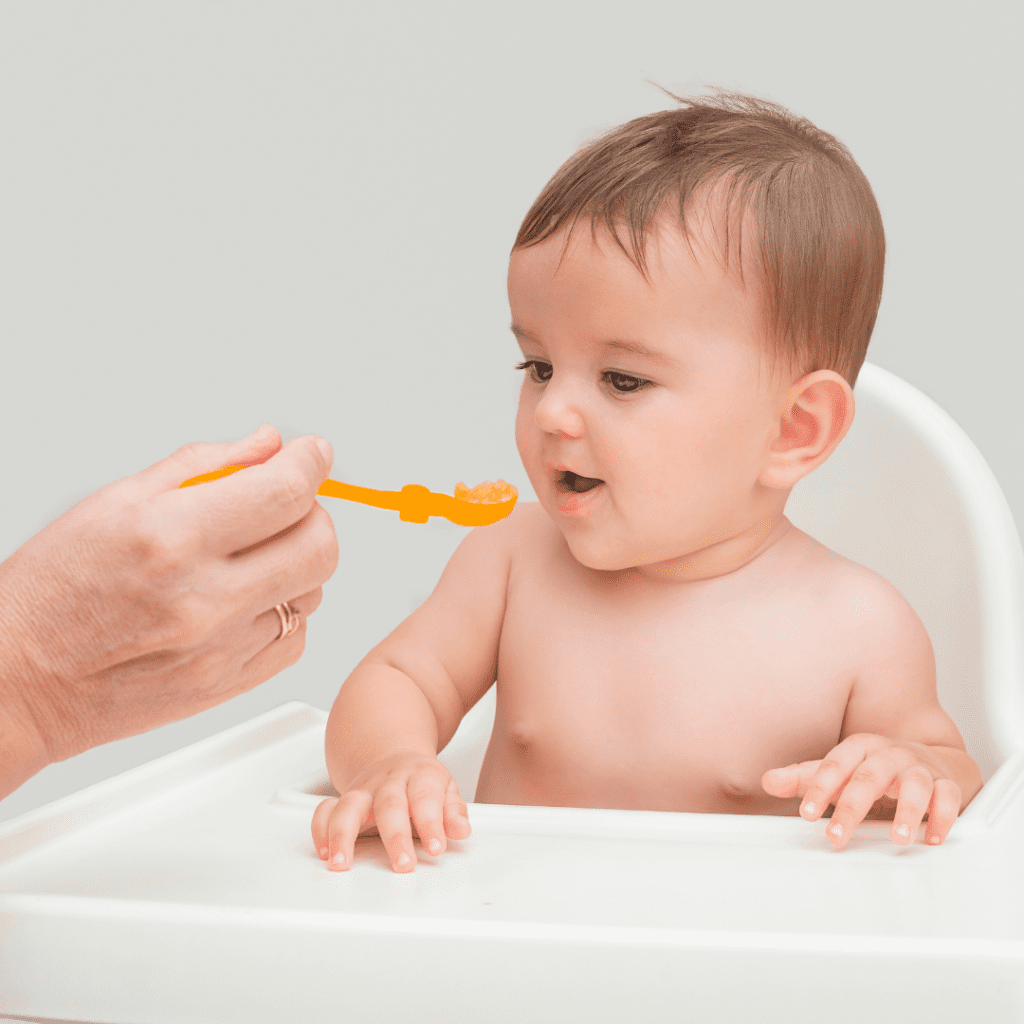- No Comments
- Edwena Kennedy, RD
Bonus Material: Sample feeding schedules
Learning to eat solids is…well…a learning process.
But what happens when weeks or months go by and your baby is still not showing interest in eating?
What if they just stare or play with the food?
What if they just bring it to their mouth but don’t eat it?
What if they lick and put it in their mouth, but then spit it out?
It can be concerning when you look around and see other babies the same age as yours who are eating and advancing in the amount and types of food ingested, while your baby seems stuck.
That’s why I’ll go over what to expect as you start solids, when to worry, and what to do if you begin to notice this. And without giving too much away, when it comes to food refusal, a lot of it hinges on your baby’s schedule. Be sure to grab my free sample schedules below so you can begin implementing my tips right away!
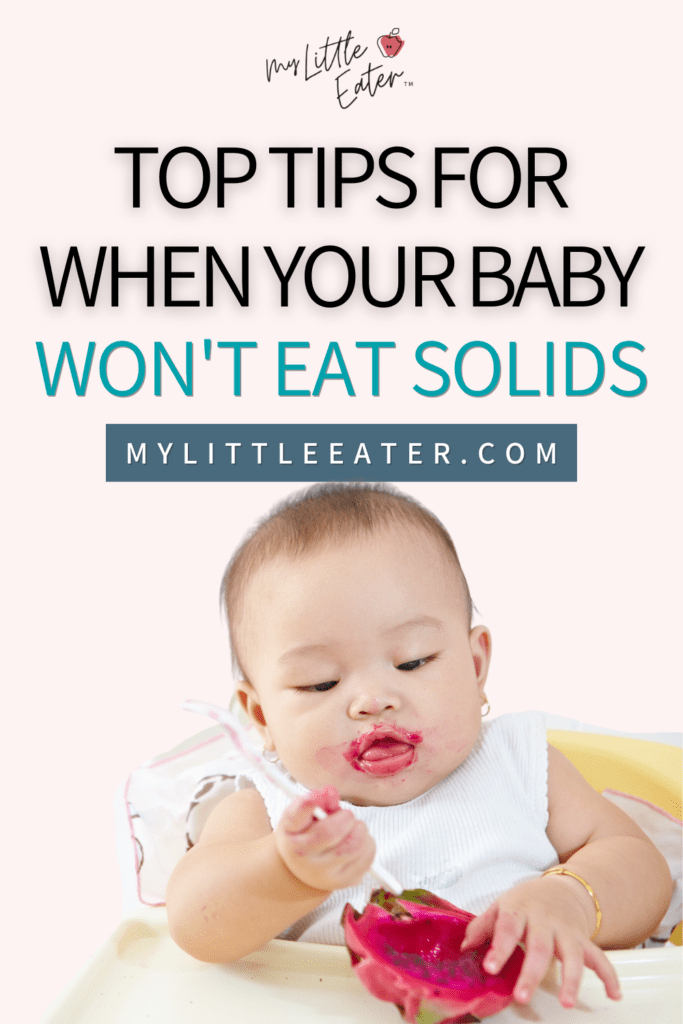
Table of Contents
Before we dive into my go-to strategies to tackle this issue, let’s first understand what to expect from babies in the first few months after starting solids (assuming you’re starting around 6 months of age, as is recommended). If you’re not clear on these recommendations, read more about the best time to start, here.
What to expect in months 6-7
In the first few weeks of introducing solids, it’s not uncommon to see babies unsure of what to do. They may display no interest at all in the food in front of them, and some may get upset after sitting in the high chair for more than a couple of minutes.
Follow our realistic example of the first week of starting solids to get an idea of what might happen and how to handle it.

This is all very normal (no matter how you decide to start, ie. with purees or finger foods). Babies still don’t understand the purpose of solids. They don’t understand that it’s something that fills them up when they’re hungry. And until they really get a taste of a few good foods, they may not even understand the enjoyment of eating and tasting different food.
Assuming your baby is starting around 6 months of age, and they’re actually developmentally ready to start table foods, seeing babies take a couple of weeks to a couple of months to really get a hang of things, is expected.
If you’re looking for information on why we don’t recommend starting earlier than this, read about the research behind our recommendation here.
What to expect in months 8-9
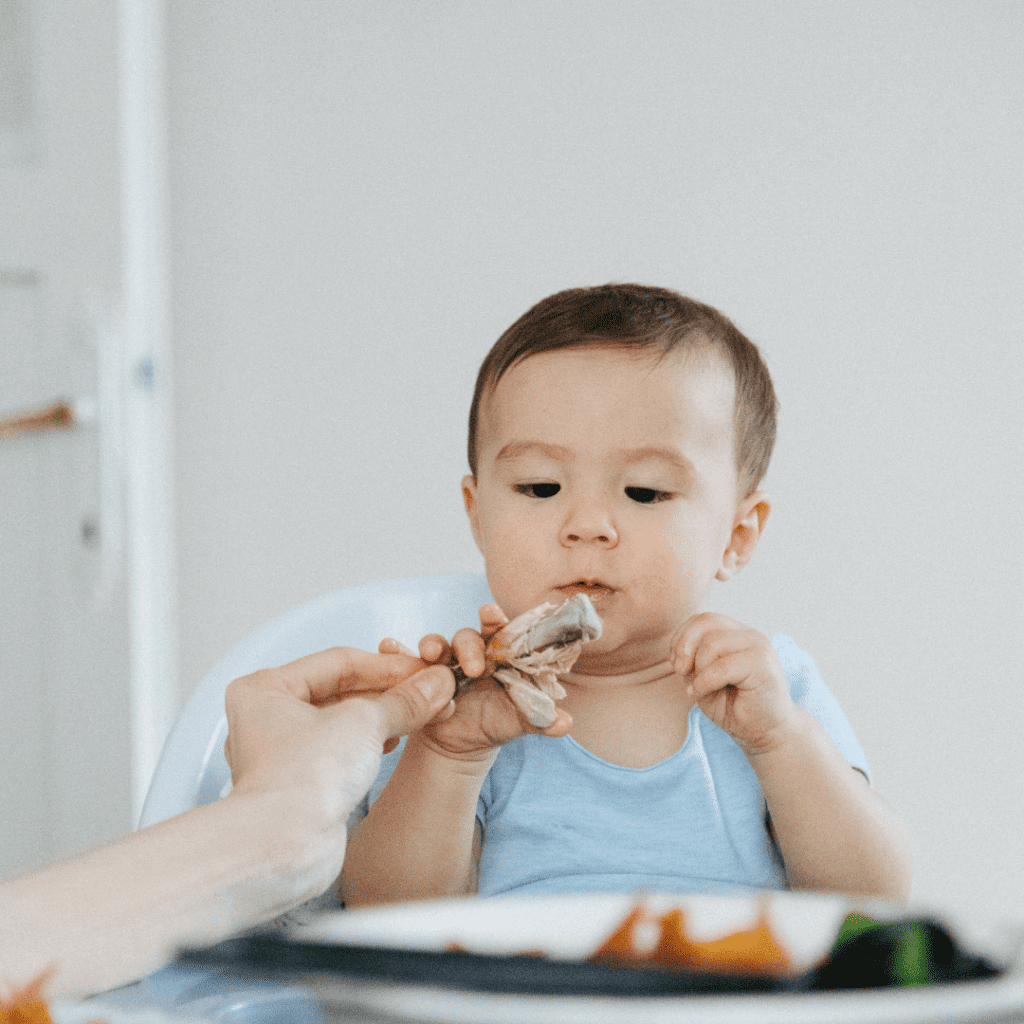
At this point, we start to troubleshoot issues more seriously (again, assuming your baby has been offered solids regularly for a couple of months). We would expect, and want, babies to eat 2 meals per day by 8 months old, and 3 meals per day by 9 months old.
Babies at this age should get better and more efficient at taking solids in as every month passes. It doesn’t mean they will be perfect, but they should be associating solids with an opportunity to fill their bellies and be actively participating in mealtime. The length of time for meals will still vary and can be impacted by many factors. Read more about that here if you’re concerned about them being too long or too short.
Should they be eating purees or finger foods by this age?
We want to see them progressing to a variety of lumpy textures and finger food options by this age. If you or your baby struggle with this, check out our FREE workshop on how to transition from purées to finger foods (without the fear) here.
We also recommend reviewing our blog on the best tips for successful baby led weaning if you’re beginning to make this transition. And if you don’t see this progress happening, you’ll want to use the troubleshooting tips below.
Tweak the feeding schedule to manage food refusal

If you’ve been offering different foods for a couple of months and your baby is still refusing to eat table foods, the first place I would look is their milk and solid food feeding schedule.
Check the gap between milk and solid foods
Make sure there are at least 30 minutes between milk and solid foods. You may even want to go up to 90 minutes to make sure your baby is showing up to the table hungry.
Note: This is a fine line to explore that might take some tweaking. Waiting too long between milk and solids can lead to a cranky, frustrated baby who’s too hungry to sit and eat. AKA don’t let them get hangry either!
Try offering solids before milk (depending on age)
If you’ve done that and your baby is 9 months old and they’re still not interested, this is where I would offer solids before milk. Sometimes babies just need a little extra nudge, and it’s really important that they’re eating 3 meals a day by 9 months old.

Delay offering milk after solids
If you’ve done that and you’re still not seeing progress, then wait at least 30 minutes after offering solids to offer milk. Sometimes a little bit longer than 30 minutes is needed so that your baby isn’t seeing milk as a backup.
Milk is so much easier to like and it’s so much easier to consume than solids. So again, they might just need a bit of help and this might just be for a short period of time to get them interested in self-feeding and loving solids.
Consider when baby's naptime is scheduled
A baby who is getting very close to their next scheduled naptime, or one who is beginning to show cues that they’re tired, is not a baby who will have the required energy to eat.
Eating is something that takes a lot of effort and energy, especially in those early months when you first introduce solids. Regardless of whether they’re having pureed baby food or you’re following the baby led weaning approach and offering table food, baby still needs to be awake enough to show interest in these new foods and have the energy needed to explore them.
If you find that mealtimes are getting too close to their naptime, consider choosing a different time of day for their solid meal. In the beginning, they really only need one meal, so feel free to move that around depending on what your baby needs that day. Early in the day is best if you’re ruling out food allergies, but otherwise, follow your baby’s cues and choose a time that will allow them to be hungry and awake enough to have interest. It’s ok if that’s different each day!
If you’re unsure how to schedule milk feedings, solid meals, and nap times for your baby, download my free sample feeding schedules and adjust them to fit your baby’s typical wake time each morning. It shows you how far to space feedings, when to offer naps, and how many meals to offer at each age.
Are they getting too much milk at night?

It could be that interest in solids during the day isn’t there because your baby is actually too full of breast milk or formula from night feedings. Remember, the recommended total number of ounces of milk consumed is for a 24 hour period.
Babies don’t need milk at night from a nutritional perspective from around 6 months of age onwards. If your baby is feeding at night (particularly if they’re doing so for long stretches of time, or for more than one feeding per night), this could be taking away from their solid food appetite during the day.
Consider removing, or significantly reducing, nighttime milk feedings to regulate hunger cues and keep appetite open during daytime hours. If you’re interested in learning more about night wakings and milk feedings, listen to our podcast with a pediatric sleep consultant, here.
Is baby getting enough solid food practice?

I want you to think about how many meals you’re offering your baby in a day. Babies need a ton of practice, and sometimes if we’re just offering a meal here and a meal there, or we’re skipping days in between, they might not be getting the practice they need to build those skills.
Babies need many, many weeks and sometimes even a couple of months of practice before they really get a hang of things. This means that the time from 6-8 months old is very important for establishing a regular and consistent mealtime routine, whether your baby is actually ingesting food yet or not.
At 6-7 months, offer 1 meal a day.
At 7-8 months, offer 2 meals a day.
At 9 months, offer 3 meals a day.
The progression in the number of meals offered every day as the months go on is just as important to follow as the consistency of daily practice with solids is. Read more about feeding schedules for babies 6-12 months, here.
Are you eating with your baby?

One of the biggest and most helpful strategies for a baby who isn’t getting the hang of what to do with solids is for parents (or one parent) to sit down and eat with their baby. Ideally, you’re eating the same food as your baby so they can see the same food on your plate and can imitate you a little easier. But even if you just have a few crackers in hand, eating in front of them shows your baby what they should do with their food as well.
Babies learn extremely well through imitation, so follow the steps below for more success.
Step 1: Get your baby's attention
Sit down to eat in front of them so that they can easily see you. You want to be the first thing they see when they look up from their tray. Get them set up in their high chair, place their food in front of them, grab your plate of food, and sit down across the table from them. This makes it easy for them to see you, plus it gives them some space to explore new food all on their own.

Step 2: Exaggerate everything
In an exaggerated way, grab a piece of food and bring it to your mouth. Bite down and show your baby how exaggerated your chewing is. Use your hands to show how your mouth opens and closes to chew. This is how to make it easy for your baby to mimic what you do.
Do this a few times, and then leave your baby alone to try it, without much more attention on them. Focus on eating your own food. (Note: I don’t mean physically leave – they need to be supervised. Just don’t hover.)
Oftentimes, babies become overwhelmed when we give them too much attention, hover over them, and stare at them. By following these steps, you’re giving them the space they need and can watch them from a distance while you model how mealtime works yourself, or with the rest of your family.
Offer food in new, big, and interesting ways
Sometimes babies are more intrigued by large, whole versions of new food than tiny bite sized pieces or purée versions of food. They’re also easier to pick up! Because fine motor skills require more concentration to master, and babies don’t hone in on those skills until they’re 9 months old or up, going bigger with food is often more enticing and easier for learning purposes.
Our Baby Led Feeding course and Texture Timeline™ Video Library show you how to do all of this safely!
Example #1:
If you’ve been leaving solid foods flat on the highchair tray, or on a plate in front of them, try instead holding the finger food vertically (upright) at eye level in front of them. This brings their attention to the food and makes it easier for them to reach out and grab it from you.
Example #2:
Offering food in new, big, and interesting ways can also mean getting them to engage with and explore big, whole pieces of food through touch and sight while you talk about the food in front of them (PS this works great for toddlers as well!).
Check out the images below of a baby exploring papaya, and another exploring fish, as whole foods. Just like they would be intrigued if you placed a large toy in front of them, and they would reach out to interact with it, placing large whole foods in front of them could be just the thing to get them interested!
Another example that would work really well would be offering them half an avocado, as opposed to cutting it into strips. Have fun with this, and explore the foods together!
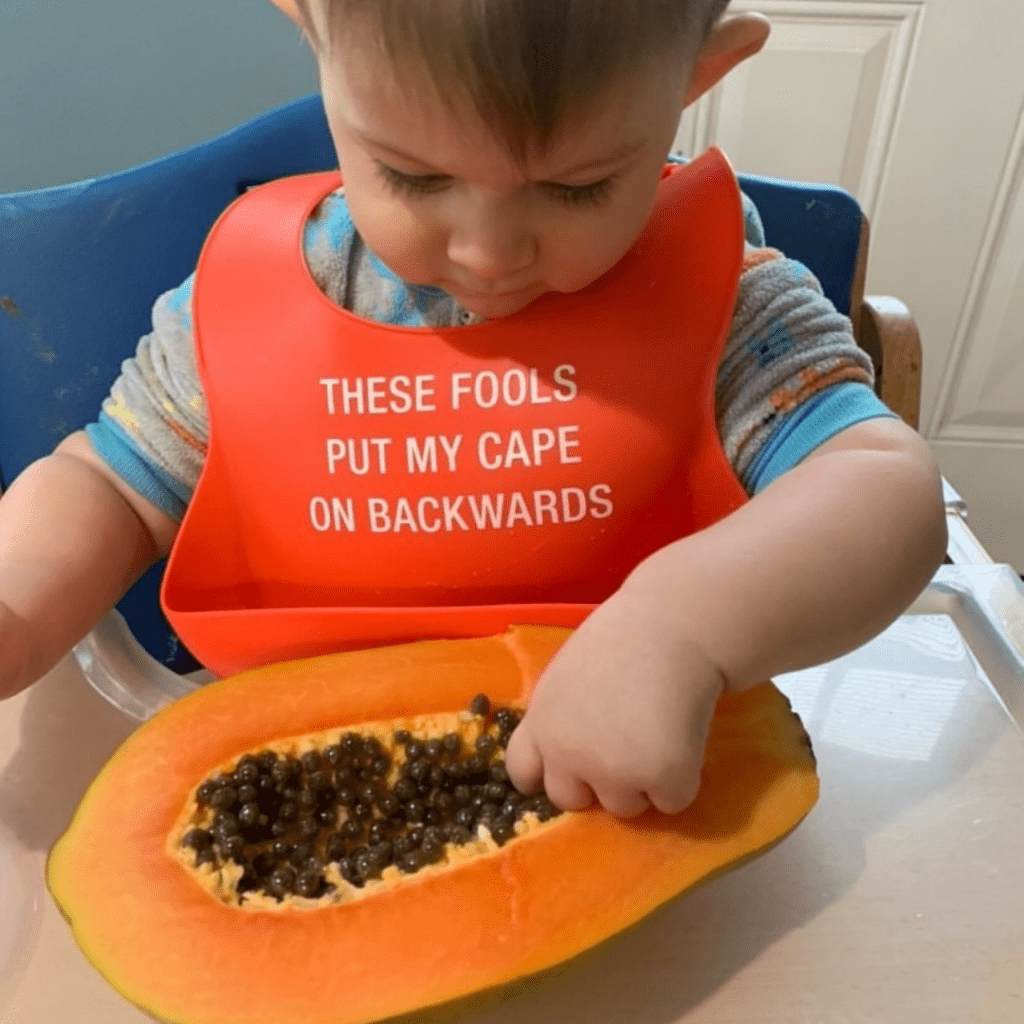
What if baby used to eat solids but then stopped?
If you had a baby that loved mealtime when you first introduced solids but all of a sudden shows no interest, prefers breast milk or formula, or is beginning to refuse certain foods, consider the following reasons.
1. Is this phase temporary due to illness or teething?
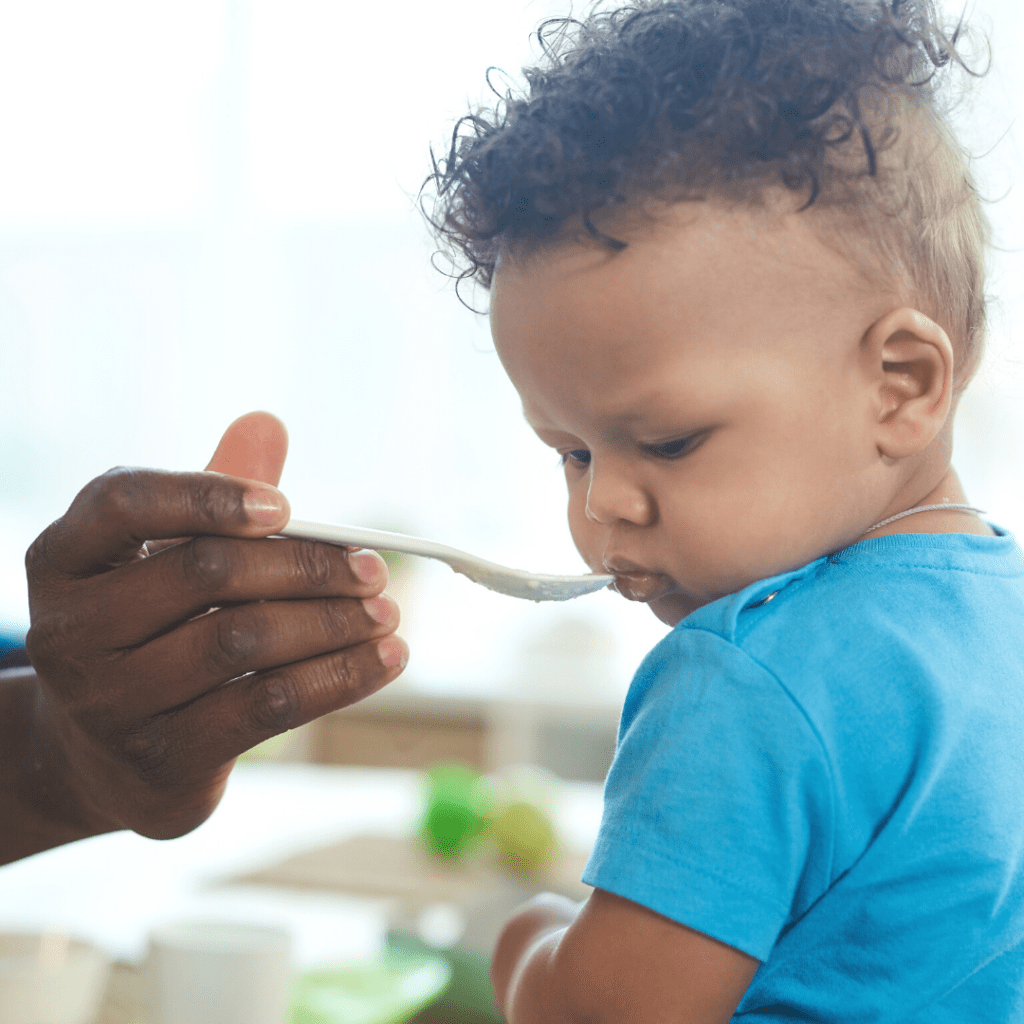
Sometimes when babies are coming down with an illness they’ll begin to refuse solid food in favor of breast milk or formula. For one, it’s easier for them to eat and requires less effort but it’s also comforting when they aren’t feeling well.
Another reason for a temporary food refusal is teething. If their gums are sore from teething it can be more painful for them to chew on solid foods and many babies show a preference towards milk feeds during this time for that reason.
In both of these cases, you should notice your baby’s interest return when they’re past the illness or the most painful part of teething (usually as the tooth is erupting). If you don’t notice their interest return, try the tips outlined above.
2. Baby needs to be challenged with new textures
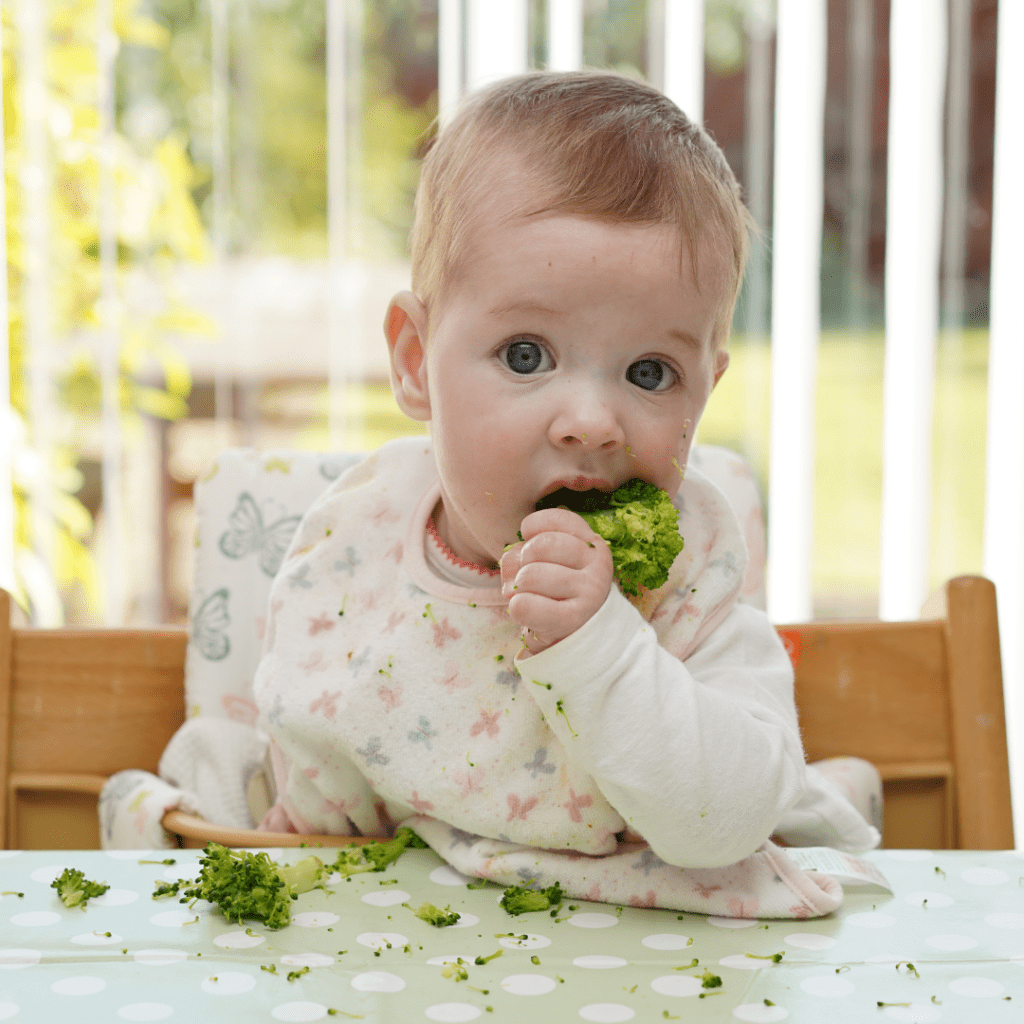
If you’ve been offering solely pureed baby food and haven’t ventured into finger foods yet, your baby may be getting bored. Essentially, they may want more of what you’re eating!
Try moving up in textures using our signature Texture Timeline™ to see how they do. If this makes you feel nervous, or you’re unsure of how to do this, sign up for our free workshop “Baby led weaning (but make it purees!): How to safely and gradually transition your baby from purees to finger foods – without fear!”. You’ll learn exactly how to use the Texture Timeline™ and will get our free Starter Guide just for listening so you can have a plan for what to try next!
3. Baby wants to self-feed
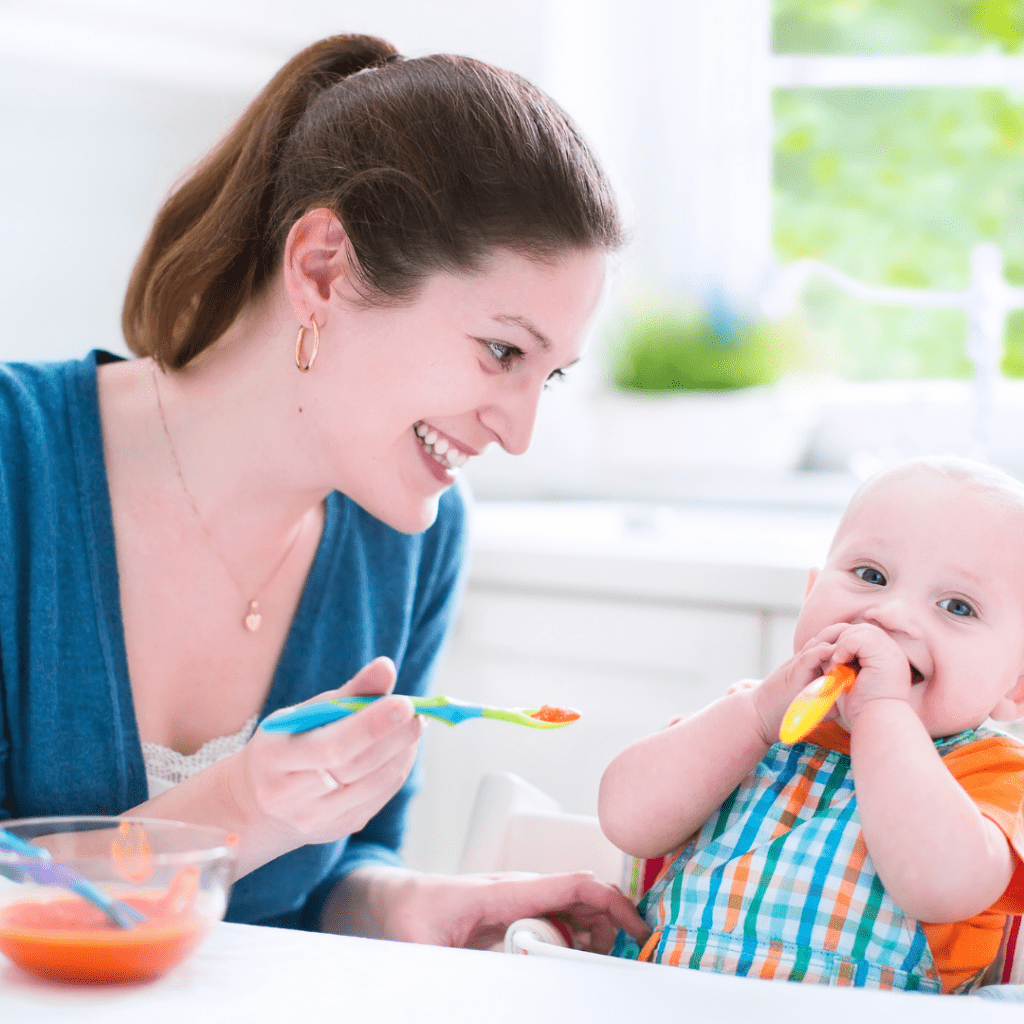
If you’ve been spoon-feeding your baby and find their interest in food seemingly disappears, they may be ready to feed themselves. You’ll know this to be the case if they turn their head away when you try to spoon-feed them, but then also reach for the spoon with their hands. Follow their cues and let them have the spoon. If they truly aren’t hungry (which is what turning their head away typically means) then they’ll just play with and explore the spoon – still a good thing!
If they’re ready to try it themselves, you’ll see them attempt to bring the spoon to their mouth. Grab a couple more spoons so you can rotate through them by preloading spoons and handing them to your baby, grabbing the one they drop when they take the new one to refill it again. Consider offering some finger foods at their next meal as well to continue to challenge them.
When to seek help from a feeding therapist
If your baby is still not showing interest in eating solids despite trying all these strategies for a month or two, or if your baby is past 9 months of age, seek out help from your doctor and ask for a referral for a feeding evaluation to rule out any medical or sensory issues.
This is especially true if your baby is gagging at the sight or touch of food, or isn’t reaching out and grabbing food, or even spoons, toys, or other objects. If you have a 12 month old or older toddler, find all the strategies to get them to learn to eat and prevent or overcome picky eating inside our Feeding Toddlers course.
The old adage of “Food before one is just for fun” couldn’t be more wrong (read more here), and we really want to tackle feeding issues with solid foods as early as possible to avoid future complications such as picky eating.
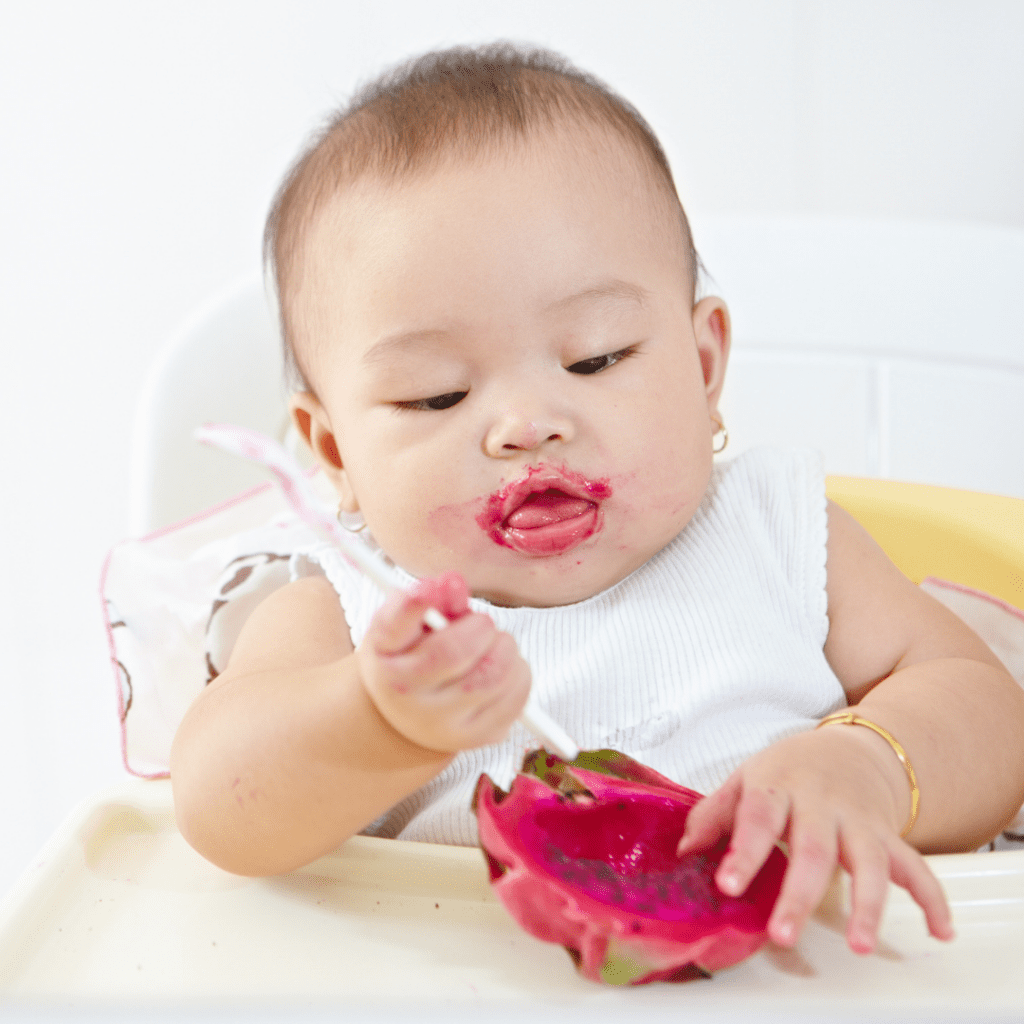
Overall, giving it time, consistency, practice, and ensuring they’re primed with a good appetite for solids is the best way to have your baby more interested in solids and on their way to becoming a healthy little eater.
Remember to download my free sample schedules for your baby so you can begin implementing these tips right away!
If you’re looking for more help for starting solids with your baby, and are ready to feel confident in knowing what to feed your baby and how to do it safely, be sure to check out our Baby Led Feeding online course for everything you need to know! I’ll walk you through starting solids with your baby, step-by-step, using whichever method you feel comfortable with to start and teach you how to gradually progress from there. Don’t spend this important milestone stressed out and worried – actually enjoy meals with your baby instead!
Was this helpful? Pin it to save for later!
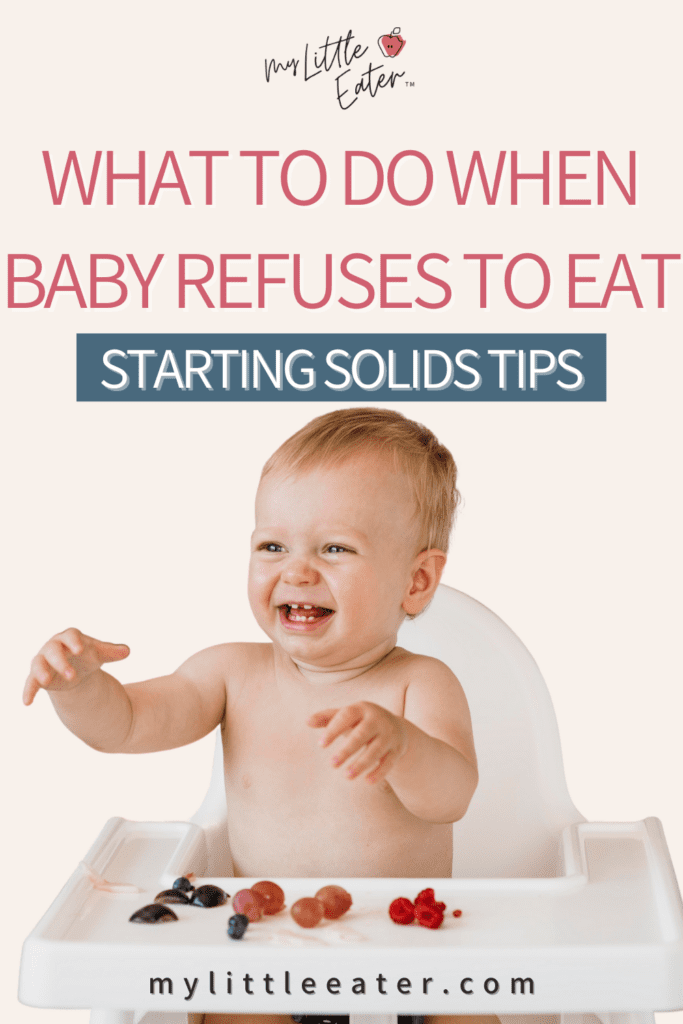

Edwena Kennedy, RD
Founder and lead Registered Pediatric Dietitian at My Little Eater Inc., creator of The Texture Timeline™, and mom of two picky-turned-adventurous eaters.

Edwena Kennedy, RD
Founder and lead Registered Pediatric Dietitian at My Little Eater Inc., creator of The Texture Timeline™, and mom of two picky-turned-adventurous eaters.
